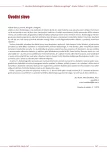Clinical significance of vascular damage in patients with diabetes and renal impairment – a nephrologist’s view
Authors:
S. Dusilová Sulková 1,2
Authors‘ workplace:
Nefrologické oddělení Kliniky gerontologické a metabolické Lékařské fakulty UK a FN Hradec Králové, přednosta prof. MU Dr. Luboš Sobotka, CSc. 2Subkatedra nefrologie Katedry interních oborů Lékařské fakulty UK a FN Hradec Králové, přednosta prof. MU Dr. J
1
Published in:
Vnitř Lék 2010; 56(4): 351-355
Category:
11th National Diabetes Symposium "Diabetes and Angiology", Hradec Kralove, 5 to 6 June 2009
Overview
Care for diabetic patients with renal impairment and vascular damage is a typical example of care requiring inter- professional approach. Vascular damage in patients with diabetes may lead to renal disease (ischemic nephropathy, high incidence but frequently unrecognised in diabetic patients). Renal ischemia resulting from hypoperfusion due to vascular changes contributes to progression of nephropathy and accelerates destruction of functional renal parenchyma. Vascular damage is the leading cause of morbidity and mortality in patients on dialysis. Amputations are reported in 6% of patients and increase the risk of death by at least 50%. All these issues highlight the need for comprehensive and early inter-professional care aimed at protecting the vascular system, i.e. recognition and, whenever possible, elimination of all factors contributing to vascular damage in diabetic patients.
Key words:
diabetes mellitus – diabetic nephropathy – ischemic nephropathy
Sources
1. Meier P, Rossert J, Plouin PF et al. Atherosclerotic renovascular disease: beyond the renal artery stenosis. Nephrol Dial Transplant 2007; 22: 1002– 1006.
2. Garovic VD, Textor SC. Renovascular hypertension and ischemic nephropathy. Circulation 2005; 112: 1362– 1374.
3. Valabhji J, Robinson S, Poulter C et al. Prevalence of renal artery stenosis in subjects with type 2 diabetes and coexistent hypertension. Diabetes Care 2000; 23: 539– 543.
4. Myers DI, Poole LJ, Imam K. Renal artery stenosis by three- dimensional magnetic resonance angiography in type 2 diabetics with uncontrolled hypertension and chronic renal insufficiency: prevalence and effect on renal function. Am J Kidney Dis 2003; 41: 351– 359.
5. KDOQI Clinical Practice Guidelines and Clinical Practice Recommendations for Diabetes and Chronic Kidney Disease. Am J Kidney Dis 2007; 49 (Suppl 2): S12– S154.
6. Courrèges JP, Bacha J, Aboud E at al. Prevalence of renal artery stenosis in type 2 diabetes. Diabetes Metab 2000; 26 (Suppl 4): 90– 96.
7. Roberts MA, Hare DL, Ratnaike S et al. Cardiovascular biomarkers in CKD: pathophysiology and implications for clinical management of cardiac disease. Am J Kidney Dis 2006; 48: 341– 360.
8. Mauri JM, Vela E, Clèries M. Development of predictive model for early death in dialysis patients entering hemodialysis: a population‑based study. Acta Diabetol 2008; 45: 203– 209.
9. Ishimura E, Okuno S, Taniwaki H et al. Different risk factors for vascular calcification in end‑stage renal disease between diabetics and nondiabetics: the respective importance of glycemic and phosphate control. Kidney Blood Press Res 2008; 31: 10– 15.
10. Combe C, Albert JM, Bragg- Gresham JL et al. The burden of amputation among hemodialysis patients in the Dialysis Outcomes and Practice Patterns Study (DOPPS). Am J Kidney Dis 2009; 54: 680– 692.
11. Rogers NM, Coates PT. Calcific uraemic arteriolopathy: an update. Curr Opin Nephrol Hypertens 2008; 17: 629–– 634.
12. Frimat L, Loos- Ayav C, Panescu V. Early referral to a nephrologist is associated with better outcomes in type 2 diabetes patients with end‑stage renal disease. Diabetes Metab 2004; 30: 67– 74.
Labels
Diabetology Endocrinology Internal medicineArticle was published in
Internal Medicine

2010 Issue 4
Most read in this issue
- Angiopathy and the eye
- Peripheral arterial disease and diabetes
- Surgical treatment of ischemic heart disease and diabetes mellitus
- Diabetes mellitus and ischemic heart disease
